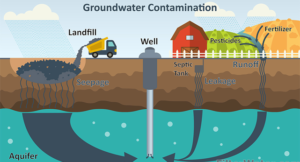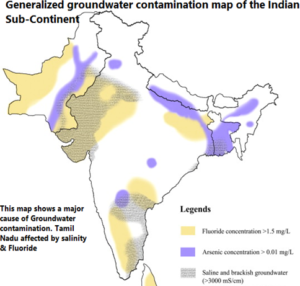Relevance: ● GS Paper I- groundwater contamination and natural resource management. ● GS Paper II-Governance and Regulatory Framework and Social Justice. ● GS Paper III- Environmental Issues,Disaster Management and Technological Solutions.
Context
The Importance of Groundwater in India, Despite India’s abundance of rivers and seasonal monsoons, groundwater remains the primary source for domestic and agricultural needs. Over 85% of rural drinking water and 65% of irrigation water come from underground

aquifers. However, the unregulated and excessive extraction of this crucial resource has led to a growing groundwater pollution crisis, which threatens the health and wellbeing of millions.
The Silent Threat: Groundwater Pollution
Once regarded as the purest natural resource, groundwater is now contaminated with nitrates, heavy metals, industrial toxins, and pathogenic microbes. These pollutants pose a serious and silent threat to public health. According to the 2024 Annual Groundwater Quality Report by the Central Ground Water Board (CGWB), more than 20% of groundwater samples from 440 districts are contaminated, primarily due to excessive use of chemical fertilizers and contamination from septic systems. In addition:

- Excessive fluoride was found in over 9% of samples, causing widespread dental and skeletal fluorosis in areas like Rajasthan, Andhra Pradesh, and Telangana.
- Arsenic levels in parts of Punjab and Bihar far exceeded the WHO limit of 10 µg/L, increasing the risk of cancer and neurological disorders.
- Uranium concentrations were reported above 100 ppb in parts of Punjab, Andhra Pradesh, and Rajasthan, largely due to phosphate fertilizers and unregulated groundwater withdrawal.
Groundwater Contamination: Escalating Public Health Crisis
Groundwater contamination has become a national public health crisis, as toxic substances in drinking water are directly linked to severe health issues.
Fluoride Contamination
- Fluoride contamination affects 230 districts across 20 states, with around 66 million people suffering from skeletal fluorosis. The condition causes joint pain, bone deformities, and stunted growth, especially in children.
- Rajasthan, Madhya Pradesh, and Uttar Pradesh have been severely impacted. In some areas, fluoride levels exceed the WHO limit, leading to widespread health consequences.
Arsenic Exposure
- Arsenic contamination is most concentrated in the Gangetic belt, affecting regions like West Bengal, Bihar, Uttar Pradesh, Jharkhand, and Assam.
- Studies show arsenic levels in places like Ballia (Uttar Pradesh) have reached 20 times the WHO limit, leading to skin lesions, gangrene, respiratory problems, and various cancers.
Nitrate Contamination
- Nitrate contamination poses a significant threat, particularly to infants, as it leads to blue baby syndrome (methemoglobinemia) i.e. where a baby’s skin turns blue.
- The 2023 National Health Profile recorded a 28% rise in hospital admissions due to acute nitrate toxicity, with regions like Punjab, Haryana, and Karnataka witnessing a sharp increase in cases.

Additional Pollutants
- Uranium contamination has risen due to excessive extraction and the use of fertilizers.
- Heavy metals such as lead, cadmium, chromium, and mercury are entering groundwater from industrial discharges, leading to developmental delays, anemia, immune system issues, and neurological damage.
The Structural Issues Behind Groundwater Pollution
The current crisis is largely due to a fragmented regulatory framework and weak enforcement mechanisms:
Weak Legal and Regulatory Enforcement
- The Water (Prevention and Control of Pollution) Act, 1974 inadequately addresses groundwater pollution, leaving a significant gap in effective regulation.
- Agencies like the CGWB, CPCB, and SPCBs operate in silos, lacking coordination and comprehensive, science-based interventions.
Over-Extraction of Groundwater
- Excessive groundwater pumping is lowering water tables and concentrating pollutants, making aquifers more vulnerable to toxins like arsenic and salinity intrusion.
- Regulatory gaps and lax enforcement encourage unchecked extraction, further exacerbating the problem.
Lack of Real-Time Monitoring
- Monitoring of groundwater quality is infrequent, and data is poorly disseminated. This lack of real-time, publicly accessible data prevents early detection of contamination, often resulting in severe health consequences before interventions are made.
Groundwater Death Zones: Case Studies
Several regions in India are witnessing groundwater contamination that has led to public health emergencies:
- In Budhpur, Baghpat (Uttar Pradesh), 13 people died within a fortnight from kidney failure, allegedly due to toxic discharges from local paper and sugar mills contaminating borewells.
- In Jalaun, residents reported petroleum-like fluids from hand pumps, suspected to be caused by underground fuel leaks.
- In Paikarapur, Bhubaneswar, sewage seepage from a faulty treatment plant caused mass illnesses.
These incidents reflect the larger systemic issues of weak enforcement, institutional apathy, and the invisibility of groundwater contamination.
Way Forward: Addressing Groundwater Pollution in India
To effectively combat groundwater pollution, a comprehensive approach is required. The following strategies must be prioritized:
● Strengthening Regulatory Frameworks
- Revise the Water Act: Amend the Water (Prevention and Control of Pollution) Act, 1974 to address groundwater pollution directly. Empower the Central Ground Water Board (CGWB) and State Pollution Control Boards (SPCBs) with greater authority for better monitoring and enforcement.
- National Groundwater Pollution Framework: Establish a unified policy to regulate groundwater contamination, focusing on industries and agricultural practices contributing to pollution.
- Enhanced Monitoring and Data Transparency
- Real-Time Monitoring: Use IoT and satellite technology for continuous groundwater quality monitoring, ensuring transparency and public access to data.
- Centralized Data Infrastructure: Build a comprehensive database on groundwater quality and quantity to track trends, support research, and guide policy decisions.
- Pollution Prevention and Remediation
- Sustainable Agriculture: Promote organic farming, crop rotation, and integrated pest management to reduce chemical fertilizer use and prevent nitrate contamination.
- Water Treatment Technologies: Invest in de-fluoridation, arsenic removal, and water filtration systems in affected areas like Rajasthan and Uttar Pradesh.
- Aquifer Restoration: Implement remediation programs to clean polluted aquifers and replenish groundwater using techniques like rainwater harvesting.
- Public Awareness and Community Involvement
- Awareness Campaigns: Launch national campaigns to educate the public, especially in rural areas, about the dangers of groundwater pollution and conservation methods.
- Community Engagement: Empower local communities and panchayats in groundwater management and pollution monitoring to encourage sustainable practices.
- Strengthening Enforcement Mechanisms
- Regulation Enforcement: Strengthen enforcement of water regulations, imposing fines and penalties for industrial discharge and unsafe practices.
- Local Authority Empowerment: Equip local authorities with the tools and resources needed for effective groundwater management and regulation enforcement.
- Policy Reforms and Funding
- Increase Budget Allocation: Increase financial support for groundwater management, pollution control, and public health programs at both central and state levels.
- Incentivize Green Technologies: Provide subsidies or tax incentives for industries and farmers adopting environmentally-friendly technologies to minimize groundwater contamination.
Conclusion:
India’s groundwater crisis is no longer just about quantity but about safety and survival. Groundwater pollution is a silent, invisible, and slow-moving threat that, if unaddressed, will have irreversible consequences. Unless urgent action is taken, India risks learning the value of clean water only when it is too late, paying a heavy price not in rupees but in lives and lost futures. Clean water is essential for life—its preservation must be a top priority for the government and society.
| Prelims practice question Q. Consider the following statements regarding groundwater contamination in India: 1- Uranium contamination in groundwater is caused due to phosphate fertilizers and unregulated groundwater withdrawal. 2 –Fluoride contamination causes skeletal fluorosis, a condition that causes joint pain, bone deformities, and stunted growth, especially in children. 3-Arsenic contamination is most concentrated in the Gangetic belt, particularly in regions such as West Bengal, Bihar, Uttar Pradesh, Jharkhand, and Assam. Which of the following statements is/are correct? A) 1 and 2 only B) 2 and 3 only C) 1 and 3 only D) 1, 2, and 3 Mains practice question Q. “Groundwater contamination in India, primarily caused by uranium, fluoride, and arsenic, presents serious public health challenges. Analyze the underlying causes, the health impacts, and propose effective policy interventions to address and mitigate these risks.” 15 Marks(250 words) |
Source: The Hindu
